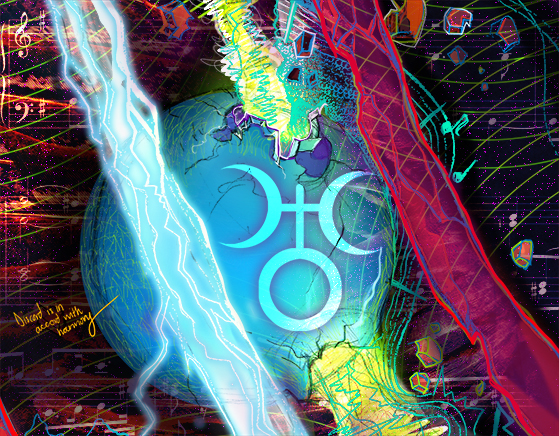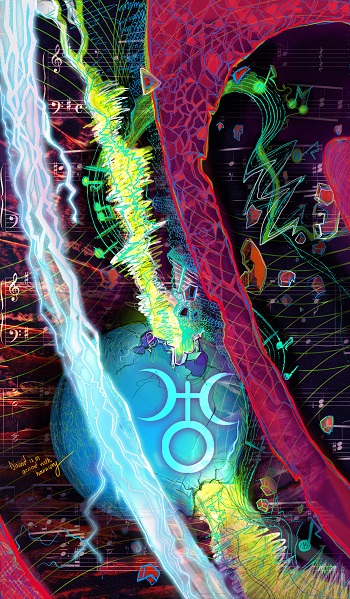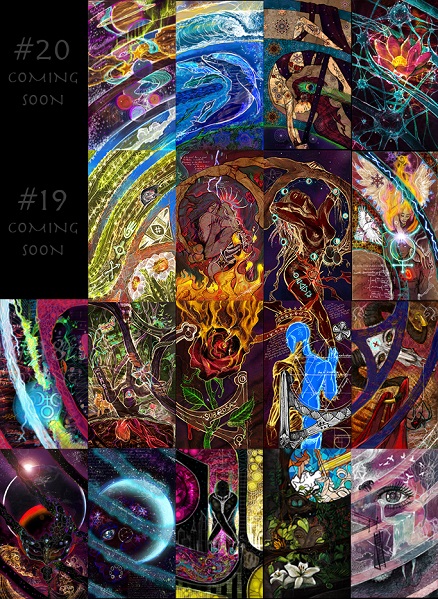The Labyrinth: A Series of Art. {Part Eighteen: Strike of Uranus}

“It doesn’t matter if you believe me or not. But common sense doesn’t really work here. You’re mad, I’m mad. We’re all mad here.” ~ Cheshire Cat
The world has gone a bit madder these days. More so, it seems, than I can remember from when I was younger.
I’m about 20 years too young to have been part of the 1960’s Civil Rights Movements and Bra-Burning eras, but I most certainly can see how a different version of this exists today, what with #MeToo, #BlackLivesMatter, and the overall tensions in the world at large. Rainforests burn, walls get built, while the climate flounders, whales beach themselves for no known reason, assault rifles at Garlic Festivals.
It’s all quite insane from my perspective.
The era of the 1960’s was a pronounced example of an era that sparked a revolution which put into motion many things still unfolding today, which have become more magnified over the past decade, to a point where nothing’s been the same since. It’s no mere coincidence either. There is a definite correlation with what went on then to what’s occurring now.
I’m sure many of you reading this remember certain shocking things from the 1960’s decade that lend to the idea: What you saw cannot be unseen. And once it’s seen, then what? It’s an idea (or a sudden shocking awakening) that changes the very fiber of your design — your wiring, in a sense.
Things that revolutionize not only a new way of viewing and seeing yourself, but also the world at large (microcosms of macrocosms) are sometimes so big that they throw a wrench in your way of being, knocking you off your axis, and you’re never the same after that.
Think back to a moment in your life where something happened to you that altered your life from that point forward. A lot of us identify with something highly traumatic, but there is also things that are highly beautiful that can have the same effect. “The kind that blindside you at 4 p.m. on some idle Tuesday.”
Well, I can tell you with a strong conviction that Uranus probably had something to do with it. “That’s random,” you might be thinking, but just like Uranus played a starring role during the 1960’s societal and social themes, he’s also playing a role now from just a slightly different position, a 90º-angle one to be specific, as it all has to do with where he hangs out in rotation with the rest of the planets.
This rotation, like a clock, repeats itself every so often, just like the hands of time.
This being said, we can trace his influence even further back in history where humanity experiences pronounced epochs of revolutionary ideas, ideals, and wars fought over things having to do with it all, like the French Revolution and the Civil War. Well, Uranus was there. He had something to do with it. Mad, right?
So let’s pause here for a moment before we go too far into the weeds, or shall I call it the outer rim? As that’s where Uranus hangs out.
He’s the seventh planet from the sun, out beyond the asteroid belt with the other gas giants and also, along with the peculiar whirling dervish called Pluto — who can’t even make up his mind whether or not he wants to be a planet at all as he spins round the sun at the farthest point — enjoying with delight his dark and transformative forays through the cosmos.
Uranus however, known as the rebel of the planet family, was discovered by the astronomer and musician William Herschel in 1781. Uranus came by his rebellious reputation, due to the fact that contrary to the rest of the planets, he whirls in retrograde — the opposite direction from everybody else. Mad!
Harboring some of the coldest temperatures in the solar system is what has earned him the notoriety of being the ice giant. Oh, and did I mention he is also tilted on his axis sideways? His ring shoots straight over his top and bottom pole (by appearances only) as his poles are actually lying latitudinally.
He orbits the sun every 84 years and his name is derived from the Greek Ouranos, who was Zeus’ grandfather. While the first five planets of the solar system were named by the Romans after their gods, Uranus is the only one named from a god straight out of Greece.
Those are some of the scientific facts of Uranus (which by the way is pronounced phonetically as Ooh-RAH-nuss, not the other pronunciation everybody likes to laugh about. All in all, he’s a little bit… well, mad! But we still love him as an essential member to our planetary family.
Without him, new ideas might never manifest and old systems wouldn’t give way for new ones. Nor would very important things be brought to light about the wrongdoings of this world.
Now I’d like to segue for a moment and talk about archetypes. For some quick Archetype 101, an archetype by definition is: “A recurrent symbol or motif in literature, art, or mythology.” That is to say, that no matter what state, country, millennia, or planet we hail from, we all relate to archetypes, as they can be found in and around all of us in a very far-reaching way.
Some philosophers consider archetypes to be the universal language, one that we can all understand, which mostly conveys itself in the form of symbolism. Mother, father, king, queen — these ideas are all considered archetypes. Bad boy, the girl next door, or a mad scientist (there’s that word again) — they all represent a generic energetic symbology that we can all relate to in one way or another.
As Richard Tarnas quotes in his book, Cosmos and the Psyche: “Knowing the basics of archetypal dynamics… allows one to bring greater awareness to the task of fulfilling one’s authentic nature and intrinsic potential… bringing greater self-awareness.”
With more self-awareness comes more compassion. As we begin to see how we are just like everybody else, our boundary of separation breaks down and the walls go away, uniting us as one unified energy, and not as isolated disingenuous beings of greed and power. We begin to relate to one another in a deeply compassionate way, through self-awareness or consciousness.
While I could spend a great deal of time dissecting and breaking down the meaning of archetypal principles, as it’s a hearty topic, I wanted to give you a basic look here so that I might better explain: Why ‘Strike of Uranus’?
As Richard Tarnas covers with exceptional detail in his book that I mentioned above, some characteristics (or rather, the archetype) of Uranus are that which I’ve listed below:
Uranus is associated with the principles of change, rebellion, freedom, liberation, reform and revolution, and the unexpected breakup of structures. Sudden surprises, revelations and awakenings, lightning-like flashes of insight, the acceleration of thoughts and events, births and new beginnings, intellectual brilliance, cultural innovation, technological invention, experiment, creativity, and last but not least originality.
We can pretty much sum up Uranus thus: He is the rebel, the awakener, the individualist, the dissident, the eccentric, the restless and wayward. (And if you’re an Aquarius, he’s your ruling planet. Can you relate?)
When you go back and look at some of the scientific (physical) facts of Uranus, you can definitely see the correlation of his soulful characteristics with his physical ones (as above — spiritual, so below — physical). His physical characteristics and behaviors definitely parallel his higher octave symbolic/spiritual ones.
Rebellious and revolutionary he is, always dancing to the beat of his own drum and doing so with precision, though possibly not always elegantly as he pummels through space on his side, going backwards. But hey, if that gets revolutionary ideas across, then by all means, go for it, man!
Therefore, when we encounter the Strike of Uranus — what this can mean, or feel like on a soulful/spiritual level, is: A sudden flash of ideas, brilliance, change, and wonder, with concentrated intensity like a bolt of lightning breaking the sky open.
And it may feel a little dismantling, shocking — in fact, it might rip you apart in discomfort — but take comfort in the idea that it is not you being ripped apart per se, it is merely an old version of you which is akin to shedding skin like a snake.
It has more to do with one’s conditioned self — the conditioned self being that which is not your wild, authentic self but more the self they told you to be, whether through upbringing or the circumstances life dealt you that you had no control over. Uranus sees to it that this breaks through. That what is inauthentic, no longer serving a purpose, shall fall away, with vigor, and a high-intensity voltage.
Authentic self and conditioned self are greatly different yet so easily mistaken. So when Uranus strikes, it can represent a feeling that’s uncomfortable, like you’re going mad or you’re losing yourself, but you’re not. Not really. But it represents a powerful volt of change towards your highest vibrational self and for your highest good, and is usually necessary to spur you on to the next great things.
It’s like a sudden burst of energy into an entirely different level, perhaps like light speed in Star Wars as they move effortlessly, but with a great burst of power from one solar system to another.

I’ll never forget one particular spring morning not too long ago, when I was driving up the freeway, commuting to work through a particularly vicious thunderstorm. The rain was so thick my windshield wipers weren’t even clearing the water. And not even 50 feet away, a lightning bolt (out of nowhere) just cracked right down into the field just off the shoulder of the freeway, right in front of me — so close!
The sound it made was ferocious, causing me to gasp out loud and hold my hand to mouth, stunned. Fortunately, I’m an excellent multi-tasker and still managed to keep control of my car while this occurred (it wasn’t like I was moving all that fast), but it was that particular feeling that the Strike of Uranus induces.
It’s so shocking it stuns you involuntarily, but at the same time you are excited and enthralled to have borne witness to something so exquisitely powerful and so up close and personal, and kind of enjoy that rush of an electrical feeling that is pulsing through your electromagnetic field, even though it’s a feeling you are unaccustomed to. It’s weird but awesome!
Strike of Uranus breaks open certain structures, and introduces something new that perhaps we never thought of or experienced before, but that we need very much to be thinking of. Like fertilizer for the plant life on this planet.
A lightning strike can dissolve unusable nitrogen in water so that plants can ingest what they need to thrive here — and of course without plants, we’d be doomed as humans. Without new ideas, this would yield the same outcome for us: doom. And sadly I fear we are careening that way now, unless we do something different and soon! Hence Uranus comes in to spur that on.
And Uranus tends to come in with the same style and intensity that a lightning bolt does, packing a wild punch, and with this it inspires solid action for a transformative high-impact move into something else that is necessary. In other words, Uranus ushers in revolution.
But as always, change is never easy, and it always seems to get worse before it gets better. Every single thing, being, plant, animal and planet has a sacred role here in this delicate ecosystem we call life, and in the ecosystem of our collective humanity, which at this point in time is undergoing some Uranic influences, which hopefully yield better, stronger ideas as time unfolds.
We’ve endured some pretty big strikes over the past decade. The air is super-charged, things are occurring underneath it all that we cannot fathom right now. But my guess is, it will yield something pretty powerful. Perhaps even phenomenal… wait for it.

This is an ongoing series by Kristi Stout. Tune in weekly for the next chapter in ‘The Labyrinth’.
If her art resonates with you, and you’d like prints, contact her through her website or Facebook.
